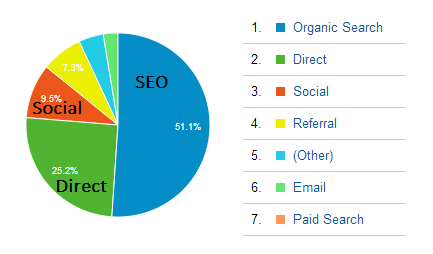Top 7 Digital Marketing Metrics Worth Losing Your Sleep Over
It is a known fact that you can’t improve what you can’t measure. One of the main advantages of digital marketing over traditional marketing is the power to measure and assign a numerical value on each step of the process…

This blessing is also a curse in disguise because we may end up measuring 50 different types of digital marketing metrics where most of them really don’t matter that much. (Example: Number of Facebook likes on a blog post!). Such metrics are aptly named as vanity metrics because the rise in numbers may be exciting but it may not lead to real growth in sales and revenue. As digital marketers we need to focus on metrics that matter.
With experience and maturity we can learn not to get excited about vanity metrics. For example, a YouTube video going viral and hitting a million views is also a vanity metric. We may feel like celebrating that the video has got a million views but in many cases viral videos have a history of having no impact on the short term or long term revenue.
So let us have a look at the top digital marketing metrics which really matter so that you can temporarily forget about the other metrics. I will divide the metrics into two major categories. Traffic and Conversion metrics.
Traffic represents the front end and conversions are the back end. It is necessary to improve the numbers of both traffic and conversions – but at the least investment of time, energy and money.
Traffic Metrics
1. Monthly Unique Visitors
2. Search Engine Organic Traffic
3. Referral Traffic
4. Returning Visitors
Conversion Metrics
5. Visitors to Leads % (and CPL – Cost Per Lead)
6. Leads to Customers Conversion % (and CPA – Cost per Acquisition)
7. Customers to Repeat Customers % (and LTV – Life Time Value of a customer)
1. Monthly Unique Visitors
No matter how poor your conversion ratios are, more traffic almost always equals more leads and hence more customers. ‘Monthly unique visitors’ is a better metric to measure than hits or page views because the latter is usually used when the main business model is selling display advertising. Some websites drive up the page views by distributing the same piece of content through several pages or slides but the number of unique visitors stay the same.
Unique visitors are calculated by a real human visitor originating from a unique IP address in a 24 hour period of time. It is like measuring how many people bought tickets to your show rather than the amount of time they spent watching your show.
Number of unique visitors coming to your website greatly varies depending on the day of the week. Some websites get more visitors on a weekend and some get the most on Monday. It is a better idea to calculate weekly unique visitors or monthly unique visitors. If you got more visitors this month than the previous month, it means you are doing something right.
2. Search Engine (Organic) Traffic
If you are doing inbound marketing to get new customers, you should expect at least 50% or more visitors coming from the search engines. For most of the bloggers, search engines have the lion’s share of visitors. For my own blog BikeAdvice.in – 51% of the new visitors from the past 3 months came through the search engines.

3. Referral Traffic
Referral traffic may not be your lion’s share of traffic but it directly influences the traffic coming from the search engines. Since search engines rank are known to rank websites better when they have more back links from other websites – referral traffic growth is a good indicator of how much your website is being shared, linked to and talked about in the web. Social media traffic can also be considered as referral traffic. Direct traffic through URL type-ins also increase with referral traffic because when your website becomes popular, people start coming to your site directly just like you visit Google.com.
4. Returning Visitors
Returning visitors is not just a traffic metric but an engagement metric. If you are doing inbound marketing and your % of returning visitors are increasing then there is a good chance that a % of these returning visitors will convert into leads and customers. If your Monthly Unique Visitors are increasing but returning visitors are going down, then you may have to start losing your sleep over it because there is no guarantee that these monthly new visitors will return in the future. No engagement means no leads and hence no customers!
Conversion Metrics
Most of the digital marketers focus mostly on traffic. That’s because more traffic easily means more revenue. Sometimes we can get caught up in the traffic numbers and lose sight of the most important marketing action – the SALES part. Traffic is the number of doors you knock into. Conversion is based on your sales message and how many sales you end up making for every hundred doors you knock. With little tweaks in the website and landing pages, sales can be increased easily without increasing the traffic. Let us look at the three most important conversion metrics:
5. Visitors to Leads %
Converting visitors into leads (or subscribers) is one of the main responsibilities of a digital marketer. You have no way to get back a visitor to your website once they leave if they do not give you their contact details (mostly just email ID). You may want to check out my previous article about Seven Powerful Ways to Convert Website Traffic Into Leads. The number of leads for every hundred visitors is the visitor to lead conversion ratio. This number can be increased by A/B split testing and applying a combination of different lead capture mechanisms as I have mentioned in the article linked above.
Visitors can be converted into leads through your blog as well as landing pages. My landing pages in a specific niche gives a visitor to lead conversion ratio of 15-20%. This means that out of every 100 visitors I get 15-20 subscribers. By calculating the short term and long term investment in gaining visitors, we can arrive at the CPL (Cost per lead) metric. This is an important number related to lead conversion ratio which helps us determine the profitability of a campaign. Such metrics also help us predict future profits as mentioned in this article: Predicting Future Web Events using the Law of Large Numbers (LLN)
6. Leads to Customers %
There is no use of having leads / email subscribers if they do not become your customers. The second major responsibility of a marketer (or digital marketer) is to convince those leads to buy your stuff. This is usually done using a series of follow up emails with a mix of educational and sales messages.
Even if the email subscriber is not interested in buying a product initially, she can be educated through a series of emails about the product. Such educational emails will fuel the desire to buy the product and when they are ready to buy a product, the buying options can be presented to them. Sales and email copy writing deserves an article on its own which I will publish soon. The digital marketer should have sound knowledge of sales psychology and enough experience to get the maximum Leads to Customer conversion ratio.
CPA or cost per acquisition is the cost of acquiring a new customer on the front end. This can be calculated from the cost per lead and lead to customer conversion ratio. For example if it costs $2 per lead on average and if out of 20 leads, 1 becomes a customer then the cost per customer acquisition is $40.
7. Customers to Repeat Customers %
The usual saying goes like this: “It is 10 times easier to convince an existing customer to buy your stuff than try to get a new customer”. Many people believe that the real revenue potential is in the back-end of the sales funnel that they are ready to even go on a loss in the front-end. Example, spend $40 to get a new customer but the initial sale will bring only a profit of $20. With future sales, the profit is realized.
Customers can be converted into repeat customers through the same marketing methods discussed above. When it comes to digital marketing, email marketing is the best tool in the hands of a digital marketer. When emails subscribers become paying customers, they are segmented into a separate list in the email marketing channel and further promotions are offered. If 100 people buy the front end product, 10 may end up buying the up-sell.
These conversion ratios are stable over large numbers as I have mentioned in this article: What can the Crime Rate in New York teach us about Predictive Web Analytics. Based on these numbers we can calculate the LTV – Life time value of a customer. This is the holy grail of all numbers / metrics.
Conclusion
These 7 metrics are limited to the marketing and especially digital marketing section. Of course there are other metrics that are even more important but does not come under digital marketing. Hope you got a good idea about these metrics. If you have any other metric in mind which you think is very important and should not be left out, leave them in the comments below.